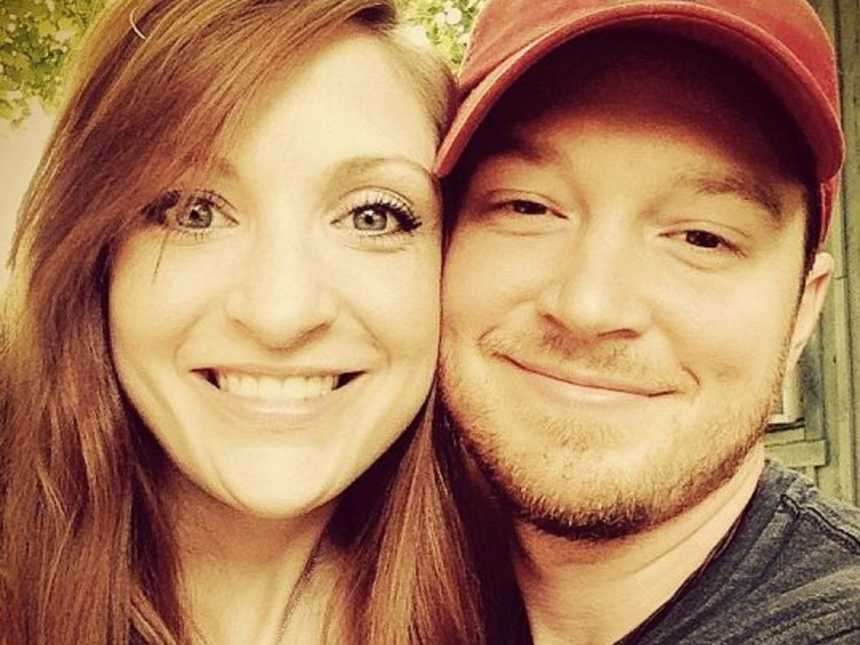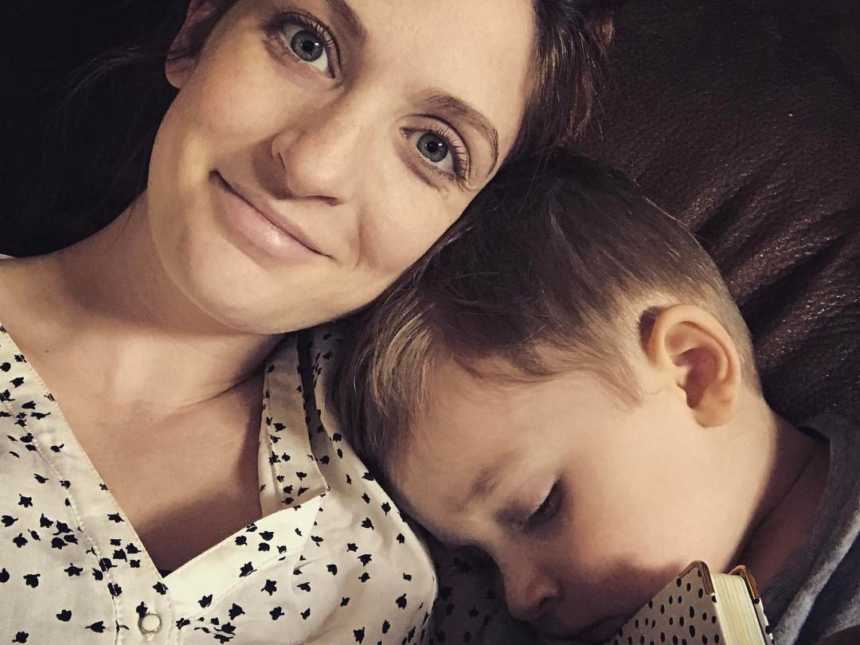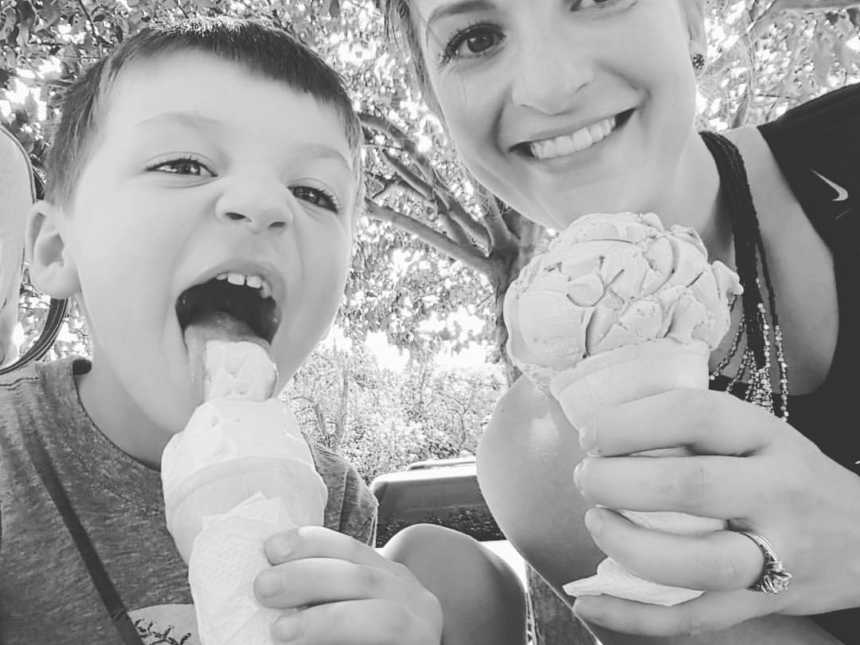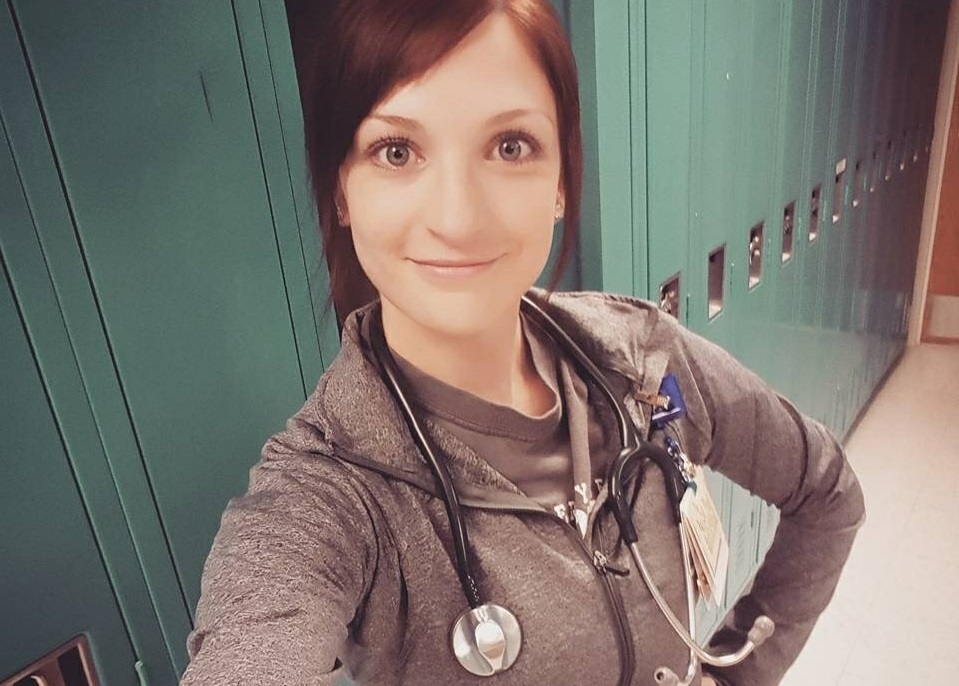One mom tells Love What Matters she can actually, physically feel when others are in pain. Megan Pohlmann of Hermann, Missouri, says she’s “always been particularly keen when it came to others’ emotions,” but now she has a name for her rare condition: mirror-touch synesthesia.
“If someone was hurting, I couldn’t let it go. It hurt me too, even if I didn’t know what the other person was upset about,” Pohlmann said.
Scientific American describes synesthesia as “an anomalous blending of the senses in which the stimulation of one modality simultaneously produces sensation in a different modality.” It reports that “synesthetes hear colors, feel sounds and taste shapes.”
Pohlmann, a pediatric nurse at St. Louis Children’s Hospital in Missouri, recalled the first time she ever felt these mysterious sensations as a 4-year-old child:
“My mother beamed with pride as she talked with the Parents as Teachers volunteer. They were chit-chatting about how at age four, I already knew my letters and numbers; I could also write my name. And, I was excited to start kindergarten in the fall.
When the pleasantries were over the lady pulled a few activities out of her Mary Poppins-style bag, which was larger than me. She lined up some wooden blocks one by one. After asking me to place them in different patterns, one on top of each other, side by side, etc., she lined up a few blocks where I could see the letters painted on them. She pulled one aside and asked me which letter it displayed.
I froze. The block was painted with a bright, primary red. The apple on the side was worn a bit, but I understood that she was trying to get me to say ‘A.’ But this was not ‘A.’ I sat in silence, afraid to look at my mom. Who the heck was this lady? She wasn’t kind like I had thought. She wanted me to believe she was kind, but really, she was setting a trap, looking at me eagerly for my answer. Maybe I wasn’t ready for kindergarten after all. And I wasn’t even sure I wanted to go anymore. Not if they had blocks like these!
My mother became uneasy. She was expecting a quick answer to fly out of my mouth, but now that I was hesitating she was becoming confused. My sudden loss of confidence was reflected back to me through my mother’s reaction; I could feel her confusion mixing with my own.
‘Tell her the letter, Megan, you know it. Remember? This one is like a triangle, remember?’ She panicked a little and gave me ‘the look.’
The letter was indeed like a triangle. But triangles are yellow. Beautiful, bright yellow like sunshine or lemons. And so was ‘A,’ which looked so much like a triangle, it made sense that they would be the same color. But this red block was nothing like sunshine or lemons. It was a crimson-colored imposter.
‘That is NOT A,’ I mustered forcefully under my breath with a hint of sass.
My mom’s confusion was spreading to the teacher. She tried to show me another block, but it was more or less the same thing. I was done with this game. Why was this teacher trying to convince me that letters are colored in any way besides what I already knew they were? ‘A’ had always been yellow. I didn’t decide it, it just was. Trying to tell me this marking was ‘A’ was like saying the sky is green or that grass is blue. It just wasn’t up for discussion. The lady brushed it off, decided it was a weird 4-year-old thing and packed up her belongings.
No one mentioned the colors of letters again until I was around 15. I received a phone call from my mom, explaining that my Grandpa, who was known to maniacally research topics of interest, had called her. He had asked some questions that were strange, even for him. She asked me to humor them both by answering a question he was asking every family member.
‘What is 3?,’ she asked. Mom expected me to answer the same as my siblings had. She thought I would say ‘a number, duh’ and we would all have a chuckle about Grandpa’s crazy side and go about our lives.
‘Blue’ I replied. I thought of the number and it appeared in my mind’s eye. The numeral rocked with peaceful purpose on its curved end like an old woman in a rocking chair. She is wearing a deep blue dress. The color of three washed over me like the soft material covering the number’s legs. Definitely blue.
I raced home to my family’s computer and, after sitting through the dial up tones, I pulled up the original Google screen. I never paid much attention to the letters on the screen before tonight. They each had a color, but my own associated color danced on top of them like markers on the old-school projection films used in my classroom. Each letter took on a color of its own like they always had despite the actual color of the font. Why was I the only one who could see these additional colors? Synesthesia.
I typed each letter slowly, like something magical was going to happen when they appeared. But all I saw were the familiar black letters accompanied by the colored film floating on top of them. Nothing out of the ordinary for me.
It took a bit of patience to search the web in its infancy. My heart skipped here and there as the results began to slowly appear. I learned, thanks to the pioneering researchers of synesthesia, just how different my brain was from other people. I also realized how lucky I was to discover this at a time where I could research and find answers. Generations before me, like my Grandpa, must have been lost without this kind of validation. Until the night of the phone call, Grandpa must have struggled with his synesthesia, not ever thinking to ask his family members if they experienced anything similar. He never knew, until that night when he was perusing the web and discovered that it runs in families.
I sat astonished while I scanned the results. My beautiful yellow ‘A’ meant I experienced grapheme-color synesthesia. My weirdness had a name! The rainbow of letters meant the language processing area of my brain was connected to the color processing area. My soft, blue grandma ‘3,’ was known as ordinal-linguistic personification. My brain was assigning human characteristics to numbers. Next, I read about a type of synesthesia that is now known as chromesthesia. I thought of listening to my Grandpa playing Chet Adkins as loud as his stereo could go. He could see the music as well as hear it, and he let the sounds and patterns surround him like a warm bath.
Chromethesia was one box I couldn’t check. I like music to surround me too, but I don’t see it. I feel it physically instead, each pluck of the guitar strings pulling on the delicate skin on my arms, a form of sound-tactile synesthesia.
I continued to scan the list describing various forms of synesthesia, finding one after the other. See your internal calendar outside of your body? Check. I thought of my week, the current day in front of me about a foot away from my face, the rest of the week waiting patiently to the right.
My family’s birthdays and other important dates sat on their individual days layered on the months, organized in a similar manner as my week. Personalities have color, texture or pattern? Yep, that one too. The more I read, the longer my list of synesthesias. That day I learned that I am a poly-synesthete.

Fast forward 15 years, and I now wholly own that characterization. It means my brain has connections, like the ones above, where other brains don’t. It allows me to experience a variety of sensations some people take drugs to experience. As it turns out, I’m like a walking acid trip! But I’m also a wife, married to an electrician and farmer husband. My two beautiful sons call me Mom or Mommy; hopefully any day now my baby daughter will mutter ‘Mama.’ I am also a nurse, a sister, a daughter, a dog person, and a gardener. Mostly, I’m a regular person with a regular family. You’d never know about these details of my brain unless you happened to catch me listening to Fleetwood Mac’s ‘Rhiannon.’ I might share with you then how the song feels like sidewalk chalk scraping on metal. Believe it or not this is a good thing! Or, if we’re in a movie, I might cover my eyes like a child because the scene is too intense, and I need to separate from the characters.
I accepted as a teen that I was different from others, but I didn’t particularly pay much attention to it back then. But after the birth of my sweet Caleb– his name chosen for the beautiful cobalt glass color of the ‘C,’ I started to really consider how different my experiences must be from others, and how different my son’s experiences could be from his peers if he were to inherit my synesthesia. Sure enough, by the time Caleb was 2 he was telling me about the stoplights beeping at him, and the buzz he heard from the light on our DVD player. He was hearing motion. If I weren’t a synesthete myself I might have been concerned, but I knew this was our family’s normal.
After the birth of my second son, Ben– a brown name with a hint of orange, like mycena mushrooms growing on a damp, fallen tree– I noticed my synesthesia becoming stronger. Or perhaps I was paying more attention to it. I had always been particularly keen when it came to others’ emotions. If someone was hurting, I couldn’t let it go. It hurt me too, even if I didn’t know what the other person was upset about. Before having my own kids, I was able to shake it off. But not anymore. The shift in my brain when I became a mother made ignoring others’ feelings impossible. I also realized something else that I had already known my whole life in the depth of my consciousness: my synesthesia extended beyond just fun-colored words.
I learned about Mirror-Touch Synesthesia years prior, but what I read focused mostly on the physicality of mirror-sensory experiences. This particular type of synesthesia is a hyper-connection involving the mirror neurons in our brains. Everyone has mirror neurons; they help us relate to and understand each other. But for people with MTS, watching another person causes the synesthete to experience the sensations of that other person as their own.

I struggled to accept my newly enhanced experiences with MTS. What was happening to me? It was so much a part of me that it was hard to imagine others didn’t have the same connections to people that I did. Eventually, I did what any self-respecting millennial does best: I searched the internet for answers. I asked the online synesthesia groups questions and described the rush of electricity that shoots up my spine when I see an injury, the overwhelming anxiety my patients experience, the fear and burden their parents carry, and how I take it on as my own. It turns out, feeling these things myself isn’t a normal human response like I thought it was. I was told by synesthesia researchers years before that yes, I had MTS.
In 2017, I read a book that changed and challenged me. Neurologist Joel Salinas, MD, writes about his own synesthesia in ‘Mirror Touch: Notes from a Doctor Who Can Feel Your Pain.’ As I turned the pages, I had to convince myself that I didn’t write this book myself. Dr. Salinas was describing my life. After pacing myself through his experiences, I came to a passage in the book where Joel describes focusing on an inanimate object to distract himself from another person’s overwhelming emotions and bring himself back into his own body. This was a technique I needed to learn! I decided I would start to shape my MTS, give it the attention it deserves, and somehow try use it as a tool for interpersonal connection.
I now do my best to do this. Everyday. In every interaction. Isn’t this the challenge we all have? Whether you are neurotypical or if you’re like me, and your neurons have a little spice or flare, we all have the capacity to treat each person as if they see the world from a unique perspective, because they do. And, we can each decide to really and truly be okay with these differences.
I watch my kids, who are so different from each other. Caleb stresses about the baby ripping, and then eating his drawings. Mothers just stop worrying about these kinds of things by the time the third one comes along, right? And then there’s Ben, giving hugs to both of his siblings, waiting anxiously for his brother to smile again. My little mirror-touch synesthete! I watch him in action and my worries for the world fade. I try my hardest to be like him, to hold on to that need for connection engrained in my neurons. That’s what I’ve learned from my synesthesia; it’s our challenge as humans, to focus on making the human connection, large or small. Once we put aside all the static, and just focus on that kindness connection, the rest, I’ve found, starts to fall in to place.”

This story was submitted to Love What Matters by Megan Pohlmann, 30, of Hermann, Missouri. Be sure to subscribe to our best love stories here.
Read more stories like this:
Do you know someone who could benefit from this story? SHARE on Facebook to make them aware there is a community of support available.


